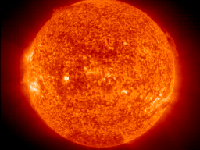Supergiants to black holes
The Sun, our nearest star, is just an average, middle-aged star. In technical terms it’s a G2 Main-sequence star, supporting a Solar System of nine planets. Other stars are much more spectacular, ranging from Blue Supergiants to Black Holes. All stars work on the same principle (nuclear fusion) where (mostly) hydrogen atoms are fused together creating helium atoms, releasing huge amounts of energy. All stars follow a preset life-cycle, determined when they are ‘born’ by how much mass they contain.
Have you ever wondered why there are different types of star?
You might like to …
• find out about the different types of star. You could start by finding and studying a Hertzsprung-Russell (HR) Diagram (a bit like a Periodic Table of Stars); use PowerPoint to make an interactive HR Diagram
• plot your own HR Diagram on Graph Paper; you will need to find a list of the twenty or thirty brightest stars as seen from Earth; try this link to get data about these stars: . You need to plot luminosity on the y-axis and surface temperature on the x-axis (unusually, the higher temperatures are usually plotted on the left, with cooler temperatures on the right – scientists don’t always do things logically!).
Have you ever wondered why there are different types of star?
You might like to …
• find out about the different types of star. You could start by finding and studying a Hertzsprung-Russell (HR) Diagram (a bit like a Periodic Table of Stars); use PowerPoint to make an interactive HR Diagram
• plot your own HR Diagram on Graph Paper; you will need to find a list of the twenty or thirty brightest stars as seen from Earth; try this link to get data about these stars: . You need to plot luminosity on the y-axis and surface temperature on the x-axis (unusually, the higher temperatures are usually plotted on the left, with cooler temperatures on the right – scientists don’t always do things logically!).


